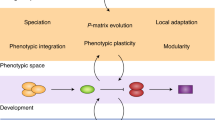Abstract
Genetic and phenotypic variance/covariance matrices are a fundamental measure of the amount of variation and the pattern of association among traits for current investigations in evolutionary biology. Still, few methods have been developed to accomplish the goal of pinpointing in which traits two matrices differ most, hampering further works on the field. We here described a novel method for dissecting matrix comparisons. This method is called Selection Response Decomposition and is an extension of the random skewers in the sense that evolutionary responses produced by known simulated selection vectors are unfolded and then compared in terms of the direct and indirect responses to selection for any trait. We also applied the method in diverse case studies, illustrating its potential. Both theoretical matrices and empirical biological data were used in the comparisons made. In the theoretical ones, the method was able to determine exactly which traits were responsible for the known a priori differences between the matrices, as well as where matrices remained similar to each other. Similar support could be observed in comparisons carried on between matrices produced from empirical biological data, since reasonable and detailed interpretations could be made regarding matrix comparisons. SRD represents an excellent tool for matrix comparisons and should provide quantitative evolutionary biology with a new method for analyzing and comparing variance/covariance patterns.










Similar content being viewed by others
References
Abdala, F., Flores, D., & Giannini, N. P. (2001). Postweaning ontogeny of the skull of Didelphis albiventris. Journal of Mammalogy, 82, 190–200.
Arnold, S. J. (2005). The utlimate causes of phenotypic integration: Lost in translation (Book Review). Evolution, 59, 2059–2061.
Arnold, S. J., Pfrender, M. E., & Jones, A. G. (2001). The adaptive landscape as a conceptual bridge between micro- and macroevolution. Genetica, 112(113), 9–32.
Cheverud, J. M. (1982). Relationships among ontogenetic, static, and evolutionary allometry. American Journal of Physical Anthropology, 59, 139–149.
Cheverud, J. M. (1988). A comparison of genetic and phenotypic correlations. Evolution, 42, 958–968.
Cheverud, J. M. (1995). Morphological integration in the saddle-back tamarin (Saguinus fuscicollis) cranium. The American Naturalist, 145, 63–89.
Cheverud, J. M. (1996). Quantitative genetic analysis of cranial morphology in the cotton-top (Saguinus oedipus) and saddle-back (S. fuscicolis) tamarins. Journal of Evolutionary Biology, 9, 5–42.
Cheverud, J. M., & Marroig, G. (2007). Comparing covariance matrices: Random skewers method compared to the common principal components model. Genetics and Molecular Biology, 30, 461–469.
Cowley, D. E., & Achtley, W. R. (1992). Comparison of quantitative genetic parameters. Evolution, 46, 1965–1967.
Falconer, D. S., & Mackay, T. F. C. (1996). Introduction to quantitative genetics (4th ed.). New York: Longman.
Houle, D., Mezey, J., & Galpern, P. (2002). Interpretation of the results of common principal components analyses. Evolution, 56, 433–440.
Krzanowski, W. J. (1979). Between-group comparisons of principal components. Journal of the American Statistical Association, 74, 703–707.
Lande, R. (1979). Quantitative genetic-analysis of multivariate evolution, applied to brain—body size allometry. Evolution, 33, 402–416.
Lush, J. L. (1964). Melhoramento genético dos animais domésticos. Rio de Janeiro: Sedegra.
Lynch, M., & Walsh, J. B. (1998). Genetics and analysis of quantitative traits. Sunderland, MA: Sinauer Assocs., Inc.
Marroig, G. (2007). When size makes a difference: allometry, life-history and morphological evolution of capuchins (Cebus) and squirrels (Saimiri) monkeys (Cebinae, Platyrrhini). BMC Evolutionary Biology, 7, 7–20.
Marroig, G., & Cheverud, J. M. (2001). A comparison of phenotypic variation and covariation patterns and the role of phylogeny, ecology, and ontogeny during cranial evolution of new world monkeys. Evolution, 55, 2576–2600.
Marroig, G., & Cheverud, J. M. (2010). Size as a line of least resistance II: Direct selection on size or correlated response due to constraints? Evolution, 64, 1470–1488.
Phillips, P. C., & Arnold, S. J. (1999). Hierarchical comparison of genetic variance-covariance matrices. I. Using the Flury hierarchy. Evolution, 53, 1506–1515.
Porto, A., Oliveira, F. B., Shirai, L. T., Conto, V., & Marroig, G. (2009). The evolution of modularity in the mammalian skull I: Morphological integration patterns and magnitudes. Evolutionary Biology, 36, 118–135.
Roff, D. A. (1997). Evolutionary quantitative genetics. New York: Chapman & Hall.
Shaw, R. G. (1987). Maximum-likelihood approaches applied to quantitative genetics of natural populations. Evolution, 41, 812–826.
Shirai, L. T., & Marroig, G. (2010). Skull modularity in neotropical marsupials and monkeys: Size variation and evolutionary constraint and flexibility. Journal of Experimental Zoology (Mol. Dev. Evol.).
Smith, K. K. (1996). Integration of craniofacial structures during development in mammals. American Zoologist, 36, 70–79.
Smith, K. K. (1997). Comparative patterns of craniofacial development in eutherian and metatherian mammals. Evolution, 51, 1663–1678.
Smith, K. K. (2001). The evolution of mammalian development. Bulletin of the Museum of Comparative Zoology, 156, 119–135.
Sokal, R. R., & Braumann, C. A. (1980). Significance tests for coefficients of variation and variability profiles. Systematic Zoology, 29, 50–66.
Steppan, S. J., Phillips, P. C., & Houle, D. (2002). Comparative quantitative genetics: Evolution of the G matrix. Trends in Ecology & Evolution, 17, 320–327.
Tyndale-Biscoe, C. H., & Mackenzie, R. B. (1976). Reproduction in Didelphis marsupialis and D. albiventris in Colombia. Journal of Mammalogy, 57, 249–265.
Acknowledgments
To those people and institutions who provided generous help and access to collections: R. Voss, E. Westwig, and A. Fleming (AMNH); L. Gordon (NMNH); J. Patton, E. Lacey, and C. Conroy (MVZ); B. Patterson and B. Stanley (FMNH). We also express our gratitude to both reviewers and the several insightful comments on a earlier version of the manuscript. Financial support was provided by Fundação de Amparo a Pesquisa do Estado de São Paulo—FAPESP, Coordenadoria de Aperfeiçoamento de Pessoal de Nível Superior—CAPES, and Museum of Vertebrate Zoology “Visiting Schoolarship”, Conselho Nacional de Desenvolvimento Científico e Tecnológico—CNPq.
Author information
Authors and Affiliations
Corresponding author
Additional information
An erratum to this article can be found at http://dx.doi.org/10.1007/s11692-012-9192-5
Electronic supplementary material
Below is the link to the electronic supplementary material.
Rights and permissions
About this article
Cite this article
Marroig, G., Melo, D., Porto, A. et al. Selection Response Decomposition (SRD): A New Tool for Dissecting Differences and Similarities Between Matrices. Evol Biol 38, 225–241 (2011). https://doi.org/10.1007/s11692-010-9107-2
Received:
Accepted:
Published:
Issue Date:
DOI: https://doi.org/10.1007/s11692-010-9107-2




